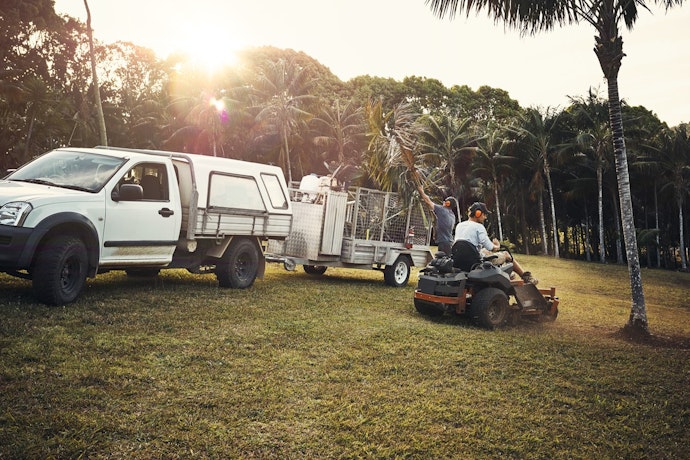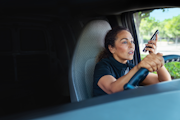How Maple Hill Lawn & Garden Created Success With Technology
Find out how Maple Hill Lawn and Garden created a successful business and leveraged GPS tracking technology to save costs...
Read more
When he started his landscaping business thirty years ago, Brian Vidinhar, Owner and CEO of Ultimate Innovations, put to use all that his father, a part-time landscaper himself, had taught him since Brian was 10 years old. "My dad taught me the landscaping trade and how to work hard," Brain explains, "so I already had a good grasp of plants and working with them. But I had to learn the ins and out of the business and the management side through making mistakes and hard knocks."
This self-learning approach has paid off. Brian started his landscaping business with one employee and 50 customers, as he handed out flyers to drum up his business. Today, the business employs 150 workers that collectively service 500 customers. It has also become a family affair, with Brian's wife working alongside him in the accounting department, and the eldest of his two daughters showing interest in possibly joining the business.
As recently as five year ago, Ultimate Innovations was a primarily "paper and pencil" operation. A lot of effort went into physically driving around and trying to locate workers or observing someone at a certain location, or trying to hear a phone ring over equipment noise in order to reach crews regarding job updates. That's not the case anymore as the company decided to think out of the box and innovate with technology as their ally.
Verizon Connect spoke to Brian Vidihar, Owner; Jack Morgan, Operations Manager; Ken Machida, Controller of Ultimate Innovations, about how they’ve used technology to keep up with the growing demands of the business. And how the innovative use of fleet technology helped them see remarkable improvements in their operations. Read on for the excerpts from the interview.
After installing our GPS technology, I noticed a pattern where one of our workers would get his crew ready, get them out the gate, and then go home... That was costing us about $180 a day. Prior to GPS, I had no idea how long that was going on, but it helped us save a lot of money once it was installed.
Q. Brian, tell us about your fleet and your business.
A. Since we're based in Hawaii, there is no seasonal break. Work is nonstop, 365 days a year. To get the job done, we manage a mixed fleet of 90-95 vehicles. Our fleet also contains cranes, roll-off trucks, ship trucks, and big international Peterbilt-type trucks.
Q. Jack, what would you say are your biggest business challenges?
A. I've been doing landscaping work for 45 years and I’ve been in management for 30 of those. I can say that one of the biggest challenges we face is team uniformity of output and production. Another challenge we have is moving our crews around the island in an efficient manner, given heavy traffic, construction, accidents and other hurdles. Keeping our vehicles in good condition to avoid road breakdowns and ensure we arrive at client location in an efficient and timely manner is an additional challenge. And, of course, in 2020 COVID-19 became a challenge for every business.
Q. Brian, did the COVID-19 pandemic change the way you conduct the business operations?
A. It did change some of our processes. Crews still meet at our base in Central Honolulu first thing in the morning, but they are required to have masks on when they enter the property and to maintain significant social distance. At punch in, we take their temperatures using a no-touch infrared thermometer. Next, they use a biometric fingerprint time clock and afterwards are required to use hand sanitizer. We also have our own ice machines for their coolers. We ask them to wash their hands with soap and water before getting ice and loading their equipment. And in the vehicles, the air conditioning must be passed over in favor of open windows.
A. Jack Morgan added: Demand has generally increased for services on the design-build side and the tree maintenance side. I attribute a lot of this to the fact that many people are working from home and spending more time there, so they are investing in their properties. They're doing work they might have deferred in the past. I would say business is quite vigorous.
Q. Jack, can you share some examples of how you use GPS technology in your business?
A. In recent months with most of our clients being at home, we've been getting more calls if a crew is a few minutes late because clients want to see if there's a problem or delay. We can use the Live Map feature to see where the crew and vehicles are, and explain that they’re held up in traffic or held back at a prior assignment. We can then give a revised arrival ETA. This helps us more effectively communicate with clients and helps improve client satisfaction.
The second example is when claims are made about one of our vehicles being involved in a bump and run. One time someone called and said they were going to alert the police that our vehicle bumped them and didn't stay around.
We were able to locate the vehicle, track it, and determine that not only did it not bump them, but it wasn't even in the vicinity of where the bump supposedly happened. When police did get in touch with us, we were able to use our GPS data to prove to them that this was a manufactured incident.
Q. Jack, what are your favorite features? Can you share some specific use cases?
A. We've been using Reveal for five years now and currently have the technology installed in 90 vehicles. We primarily use it for GPS tracking. My favorite feature is Live Map, which I use every day to locate vehicle positions, and make sure that they are where I think they ought to be. Occasionally, I get alerts about speed or other driving issues that I can verify by locating the vehicle in terms of what road or highway it’s on. It might require me to send that crew a message to slow it down. Or, if there are reports of accidents on the freeway that are blocking lanes, I can contact the crew and have them route around that site as they go to their next assignment.
GPS tracking has really helped us in many ways. It's helped us optimize our routes by providing drivers with the shortest routes to our clients to minimize drive times. It's also helped us locate three stolen vehicles. In one case, we watched live video of the stolen vehicle and were able to give police turn-by-turn directions regarding where it was going in order to recover it quickly.
In addition to GPS, we do use the reports function from time to time. When you have a truck that's essentially a rolling billboard, there's a tendency for people to call us and tell us about how our team is driving, good or bad. We can use reports to verify a vehicle’s position and determine if what we're being told is true or just a prank call.
We also use replay to backtrack a situation if we have any concerns about where a vehicle might've been. And we do load speed and driving style alerts to help in areas where we know excessive speed could be a problem for the team.
Q. How do you use GPS technology and reports to help train drivers?
A. (Brian) We understand traffic moves quickly in some areas. I'm not so much concerned when our crews are moving along with traffic, because we don’t want to be an impediment any more than we want to be a standout.
But at times it's evident that a driver was a little heavy-footed, so we'll bring them in and use the report to have a conversation about what safe driving means to the company and to them personally, given they get the ticket but the company gets black eye.
Q. Brian, how has Reveal from Verizon Connect helped you deal with customer service?
A. When Jack gets a phone call from a client who needs a quick response, he can easily see which crew is the closest to that job site and deploy them to help. Before implementing GPS tracking, we had 400-450 customers. Now, we have well over 500 and it helps keep us efficient and responsive to them all.
The other thing that GPS has done is help us when clients say, "Your crew has only been here for fifteen minutes. How could they service my property in fifteen minutes?" We're able to go back and check the reports and see that's not exactly true. The truck's been there for an hour, and we've been able to show the client a report on that fact. This helps clear up misunderstandings right away.
Q. Brian, what tips would you give other landscape businesses when it comes to introducing GPS tracking to employees?
A. I'd say lead with positives. The main reasons I put in GPS were to provide better customer service, increase employee safety and to be able to dispatch jobs more efficiently. For instance, we've had situations where trucks have broken down on the side of the road and we didn't have a good description of exactly where. With GPS, we're able to precisely locate them and quickly get them some help.
Explaining these underlying reasons goes a long way toward how the new GPS tracking is presented. When we first implemented it, we tested it out. We made sure everything was working well.
Then we presented the technology to the whole company, highlighting the positive aspects of having a GPS locator in a vehicle, including antitheft protection, cost savings and improved productivity. But we were transparent in also highlighting that it gives us the ability to monitor driving style, driving activities and location. We didn’t get any negative reactions.
Q. Ken and Brian, are you able to quantify the impact Verizon Connect GPS tracking technology has had on Ultimate Innovations?
A. Through improved accountability of staff whereabouts and routing efficiency we’ve achieved an estimated cumulative savings of $500K over 5 years, approximately $100K annually, since implementing the technology.
In terms of labor, we estimate this could be tens of thousands of dollars, especially in terms of overtime savings due to efficiency gains. And though we can't quantify exact fuel usage savings, we can say that people aren't stealing fuel from the company and we’ve seen much less fuel waste. In fact, we’ve seen much less waste in general.
For instance, I can share this story. After installing our GPS technology, I noticed a pattern where one of our workers would get his crew ready, get them out the gate, and then go home. One day, I called him into my office and pulled up the GPS reports on his truck and asked him, "Isn't this your truck?" He confirmed it was. I then said, "Well, it looks like you come to work and then you go home."
He was shocked, and the behavior stopped from that moment on. That was costing us about $180 a day. Prior to GPS, I had no idea how long that was going on, but it helped us save a lot of money once it was installed. It also ultimately saved us a lot of time over the manual tracking and literal phone-based follow-ups we'd been doing. And it definitely prepared us to better rise to the operational challenges we faced in 2020, as well as prepare us for future challenges to come.
Tags: Fleet utilization, Safety



Find out how our platform gives you the visibility you need to get more done.
Find out how Maple Hill Lawn and Garden created a successful business and leveraged GPS tracking technology to save costs...
Read moreHear Champion Trucking’s real-life story of investigating a harsh driving incident with the help of a dashcam and how...
Read moreDallas Plumbing uses GPS fleet tracking from Verizon Connect to lower costs, increase efficiency, and grow in the competitive...
Read moreLearn how video solutions with intelligent analysis capabilities can help benefit your drivers and enhance safety programs.
Read more
Get your free 2024 Fleet Technology Trends Report and see how organizations are: